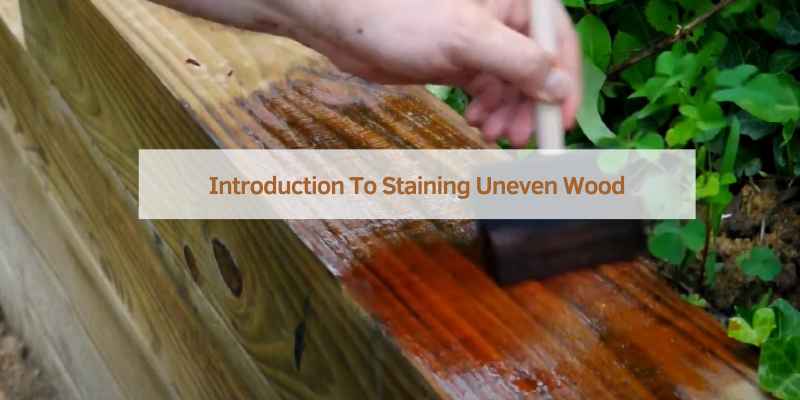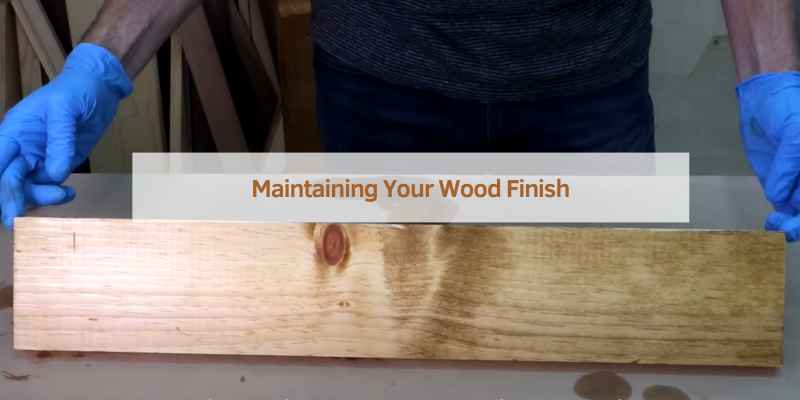To stain uneven wood, sand it evenly first, then apply a pre-stain wood conditioner before staining. Staining uneven wood can be a challenging task, but with the right techniques, you can achieve a beautiful and consistent finish.
Uneven wood surfaces can result in a blotchy or streaky stain application if not properly prepared. By sanding the wood evenly and using a pre-stain wood conditioner, you can ensure that the stain is absorbed uniformly, resulting in a more professional-looking finish.
In this blog post, we will explore the step-by-step process of staining uneven wood to help you achieve a flawless and consistent result. Let’s dive in and learn how to transform your uneven wood surfaces into stunning stained masterpieces.
Introduction To Staining Uneven Wood
Staining uneven wood can be a challenging task, but with the right techniques and approach, you can achieve a flawless finish that enhances the natural beauty of the wood. In this article, we will explore the challenges that come with staining uneven wood and discuss the goal of achieving a flawless finish. By understanding these key aspects, you will be well-equipped to tackle your next staining project with confidence.
Challenges With Uneven Wood
Uneven wood poses unique challenges when it comes to staining. The unevenness can be caused by variations in the wood grain, previous finishes, or natural imperfections. These inconsistencies can result in an uneven absorption of the stain, leading to a blotchy or streaky appearance.
To overcome these challenges, it is important to prepare the wood properly before applying the stain. This may involve sanding the surface to create a smooth and even texture, removing any previous finishes or coatings, and filling in any gaps or cracks that may disrupt the staining process. By addressing these issues, you can create a more uniform surface that will allow the stain to penetrate evenly.
Goal Of A Flawless Finish
The ultimate goal of staining uneven wood is to achieve a flawless finish that showcases the natural beauty of the wood while ensuring an even and consistent color. A flawless finish not only enhances the aesthetic appeal of the wood but also provides protection against moisture, UV rays, and general wear and tear.
To achieve this goal, it is essential to choose the right stain for the wood type and desired look. Additionally, applying the stain in thin, even coats and allowing sufficient drying time between applications will help prevent uneven absorption and ensure a smooth and consistent color. By following these steps and taking the necessary precautions, you can achieve a flawless finish that will leave your wood looking stunning.

Tools And Materials Needed
When it comes to staining uneven wood, having the right tools and materials is crucial for achieving a professional and even finish. Before you begin the staining process, it’s important to gather all the necessary items to ensure a smooth and successful application.
Choosing The Right Stain
Before selecting the tools and materials for staining uneven wood, it’s essential to choose the right stain. Opt for a gel stain for a more controlled application on uneven surfaces. Gel stains are thicker and provide better coverage on wood with variations in texture and porosity.
Essential Tools For Application
When it comes to staining uneven wood, the following tools and materials are essential for achieving a professional and even finish:
- Quality Stain Brush: A high-quality stain brush with fine bristles ensures smooth application and even coverage on uneven wood surfaces.
- Pre-Stain Wood Conditioner: This helps to prepare the wood for staining and promotes uniform color absorption, especially on uneven surfaces.
- Stir Stick: Ensure thorough mixing of the stain to achieve a consistent color before application.
- Clean Cloths: Use lint-free cloths for wiping off excess stain and achieving a uniform finish on uneven wood.
- Sandpaper: Different grits of sandpaper are essential for preparing the wood surface and addressing any uneven areas before staining.
- Protective Gear: Safety goggles, gloves, and a respirator mask are essential for personal protection during the staining process.
Preparation Of The Wood Surface
Cleaning The Wood
Start by clearing the wood of any dirt or debris.
Use a damp cloth to wipe the surface clean.
If needed, apply a wood cleaner for stubborn stains.
Sanding Techniques
Begin sanding with coarse grit sandpaper.
Gradually switch to finer grits for a smooth finish.
Ensure even sanding for a uniform stain application.
Applying Pre-stain Wood Conditioner
To achieve a smooth and even stain on uneven wood surfaces, it is important to apply a pre-stain wood conditioner. This conditioner helps to seal the wood and prevent blotching, allowing the stain to penetrate evenly for a professional finish.
Follow these steps to ensure a successful staining process.
Before staining uneven wood, it is important to apply a pre-stain wood conditioner. This will help to even out the absorption of the stain, resulting in a more uniform finish. In this section, we will discuss the benefits of using a pre-stain conditioner, as well as how to apply it properly.
Benefits Of Pre-stain Conditioner
There are several benefits to using a pre-stain conditioner before staining uneven wood. These include:
- Minimizes blotching and streaking
- Helps to create a more uniform finish
- Improves the overall appearance of the wood
- Increases the longevity of the stain
How To Apply
Applying a pre-stain wood conditioner is a relatively simple process. Follow these steps to ensure the best results:
- Clean the wood surface thoroughly to remove any dirt or debris
- Apply the pre-stain conditioner evenly using a clean brush or cloth
- Wait for the recommended amount of time specified on the product label
- Wipe off any excess conditioner with a clean cloth
- Allow the wood to dry completely before applying the stain
It is important to note that different types of wood conditioners may have different application instructions. Always read the product label carefully before use.
By following these simple steps, you can ensure that your uneven wood is properly prepared for staining. Applying a pre-stain wood conditioner will not only improve the appearance of the wood, but it will also help to prolong the life of the stain.
Staining Techniques For Uneven Surfaces
Staining uneven wood can be a challenge, but there are techniques to achieve a beautiful finish. Sanding the surface, using a pre-stain conditioner, and applying multiple coats can help achieve an even stain on uneven surfaces.
Brush Vs. Rag Application
When it comes to staining uneven wood surfaces, choosing the right application technique can make a significant difference in achieving a uniform and professional finish. Two common techniques for applying stain to uneven surfaces are using a brush or a rag.
Brush Application
Using a brush to apply stain allows for better control and coverage on uneven wood surfaces. The bristles of the brush can reach into crevices and recesses, ensuring that the stain evenly coats the entire surface. It is important to use long, even strokes in the direction of the wood grain to avoid streaks or unevenness. Brush application is ideal for larger projects or surfaces with intricate details.
Rag Application
For smaller or more delicate projects, using a rag to apply stain can provide a smoother and more subtle finish. This technique allows for better control over the amount of stain applied, making it easier to achieve a desired level of color intensity. When using a rag, it is important to work in circular motions and blend the stain evenly across the surface. This method is particularly useful for antique or vintage pieces where a more aged or worn look is desired.
Dealing With Dark Spots And Blotches
Uneven wood surfaces often come with the challenge of dark spots and blotches that can disrupt the desired finish. However, there are techniques you can employ to address this issue and achieve a more consistent appearance.
Pre-Stain Wood Conditioner
Using a pre-stain wood conditioner is an effective way to minimize the occurrence of dark spots and blotches. This product helps to seal the wood and create a more uniform surface for the stain to adhere to. Apply the wood conditioner evenly using a brush or rag, following the manufacturer’s instructions. Allow it to penetrate the wood for the recommended time before applying the stain.
Stain Layering
Another technique to mitigate dark spots and blotches is layering the stain. Apply a light coat of stain to the entire surface and allow it to dry completely. Then, assess the appearance and determine if additional coats are needed to even out the color. Apply subsequent coats in thin layers, allowing each layer to dry before adding another. This gradual buildup of stain can help blend any unevenness and create a more consistent finish.
Blotching Control Products
In some cases, using blotching control products specifically designed for staining uneven wood surfaces can be beneficial. These products help to minimize the absorption of stain in certain areas, reducing the appearance of dark spots and blotches. Follow the instructions provided by the manufacturer to ensure proper application and achieve the desired result.
Remember, when staining uneven wood surfaces, it is important to test the chosen technique and products on a small, inconspicuous area first to ensure the desired outcome. Patience and attention to detail are key in achieving a beautiful, even finish on uneven wood surfaces.
Achieving An Even Finish
Layering Stains For Depth
Apply light stain coats to even out the color.
Use a variety of stain shades for depth.
Wiping Off Excess Stain
Wipe excess stain with a clean cloth.
Ensure an even finish by gentle wiping.
Post-stain Treatments
Enhance the look of uneven wood by applying post-stain treatments like sanding or restaining specific areas. Achieve a more uniform finish by carefully addressing the variations in the wood’s absorption levels.
Once you’ve applied the stain to your uneven wood, it’s essential to carry out post-stain treatments to achieve an even finish. These treatments include applying sealants and sanding between coats. Here’s what you need to know about each post-stain treatment.
Applying Sealants
After staining the wood, the next step is to apply a sealant to protect the surface and achieve a smooth finish. Sealants come in different types, including water-based and oil-based. Water-based sealants dry quickly and have less odor, while oil-based sealants take longer to dry and have a stronger odor.
To apply the sealant, use a brush or a spray gun, depending on the type of sealant and the wood’s size. Apply the sealant in thin coats, allowing each coat to dry completely before applying the next coat. Check the manufacturer’s instructions for the recommended number of coats.
Sanding Between Coats
Sanding between coats is a crucial step in achieving an even finish. It helps to remove any imperfections and rough spots, leaving a smooth surface for the next coat of sealant. Sanding also helps the subsequent coats of sealant to adhere better to the wood.
To sand between coats, use a fine-grit sandpaper or a sanding block. Sand the surface lightly, making sure to remove any raised grain or rough spots. Wipe the surface with a tack cloth or a damp cloth to remove any dust or debris before applying the next coat of sealant.
In conclusion, post-stain treatments are essential to achieving an even finish on uneven wood. Applying sealants and sanding between coats can make a significant difference in the final outcome. Make sure to follow the manufacturer’s instructions and take your time to achieve the best results.
Troubleshooting Common Issues
To resolve uneven wood staining, start by sanding the surface thoroughly to create a uniform texture. Apply a pre-stain wood conditioner before staining to help achieve an even color. Test the stain on a small area first and apply multiple coats if needed to achieve the desired color consistency.
Staining uneven wood can be a frustrating task, especially when you encounter common issues such as stain not taking or fixing overlap marks. However, with a little bit of troubleshooting, you can easily overcome these problems and achieve a beautifully stained surface. In this section, we’ll cover the most common issues when staining uneven wood and provide you with tips and tricks to fix them.
Stain Not Taking
If you notice that your stain is not taking to the wood in certain areas, it could be due to a few reasons. One reason may be that the wood is too smooth or has a sealer or finish on it that is preventing the stain from penetrating. To fix this, you can sand the surface of the wood with a fine-grit sandpaper to create a more porous surface for the stain to adhere to.
Another reason why stain may not be taking to the wood could be that the wood is too dry. In this case, you can try applying a pre-stain conditioner to the wood to help it absorb the stain more evenly. Be sure to follow the manufacturer’s instructions for the pre-stain conditioner as it may vary depending on the product.
Fixing Overlap Marks
Overlap marks occur when you apply too much stain in one area, causing it to overlap onto the next area. To fix this issue, you can use a clean cloth or rag to gently rub the affected area and blend the stain together. Be sure to use a light touch and work in the direction of the wood grain to avoid creating more overlap marks.
If you have a large area with overlap marks, you may need to sand down the affected area and reapply the stain. Be sure to use a fine-grit sandpaper and work slowly to avoid damaging the wood.
By troubleshooting common issues when staining uneven wood, you can achieve a beautifully stained surface without the frustration. Remember to sand the surface of the wood if the stain is not taking, and use a pre-stain conditioner for dry wood. If you encounter overlap marks, gently blend the stain with a clean cloth or sand down the affected area if necessary. With these tips and tricks, you’ll be able to stain uneven wood like a pro.
Maintaining Your Wood Finish
Proper maintenance is key to preserving the beauty and longevity of your stained wood. By following these simple tips, you can keep your wood looking fresh and vibrant for years to come.
Regular Cleaning Tips
- Dust with a soft cloth weekly
- Use a mild soap and water solution for tougher stains
- Avoid harsh chemicals that can damage the finish
When To Re-stain
- Check for fading or wear every 1-2 years
- If water no longer beads on the surface, it’s time to re-stain
- Consider re-staining before significant damage occurs

Frequently Asked Questions
How Can I Prepare Uneven Wood For Staining?
To prepare uneven wood for staining, start by sanding the surface to create a smooth and level base. Use a wood filler to fill in any gaps or holes, then sand again for a consistent texture. Finally, apply a pre-stain wood conditioner to help the stain absorb evenly.
What Are The Best Techniques For Staining Uneven Wood?
When staining uneven wood, consider using a gel stain, as it can help to achieve a more uniform finish. Apply the stain in thin, even coats, and wipe off any excess to prevent blotching. Additionally, consider using a wood conditioner beforehand to promote even absorption.
Can I Use Different Colors Of Stain To Camouflage Uneven Wood?
Yes, using different colors of stain strategically can help to camouflage uneven wood. Consider using a darker stain to minimize the appearance of imperfections, or experiment with layering different shades to create a unique, blended look that distracts from any unevenness.
Conclusion
Staining uneven wood can be a challenging but rewarding process. By following the right techniques and using quality products, you can achieve a beautiful and consistent finish. Remember to prepare the wood properly, apply the stain evenly, and seal the surface for long-lasting results.
With patience and attention to detail, you can transform uneven wood into a stunning piece of furniture or decor.


